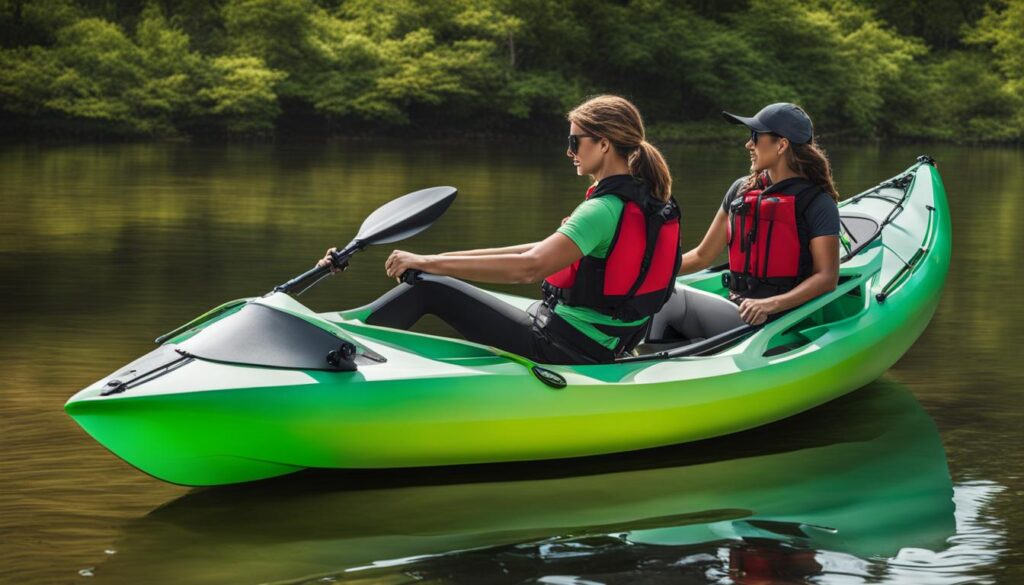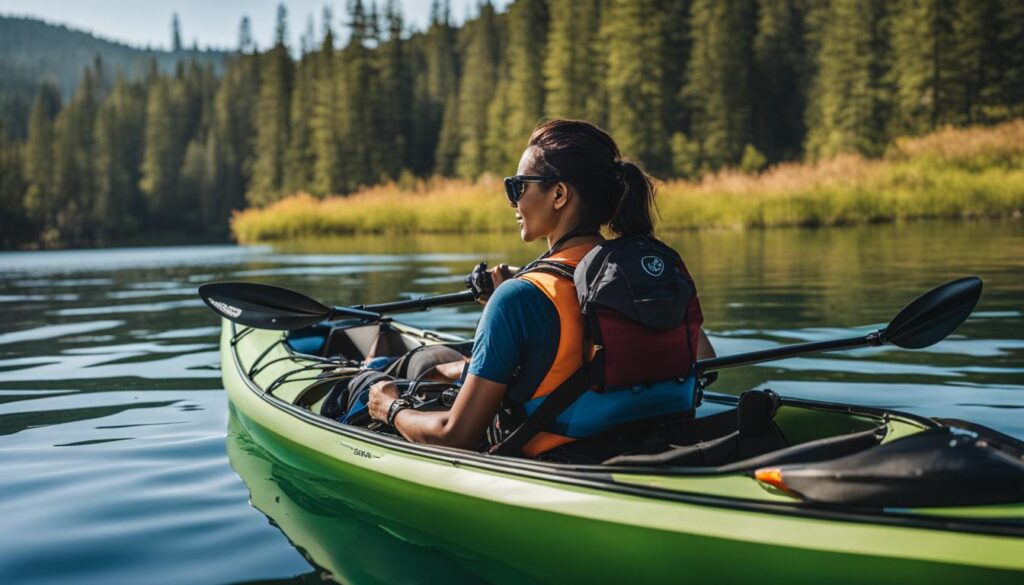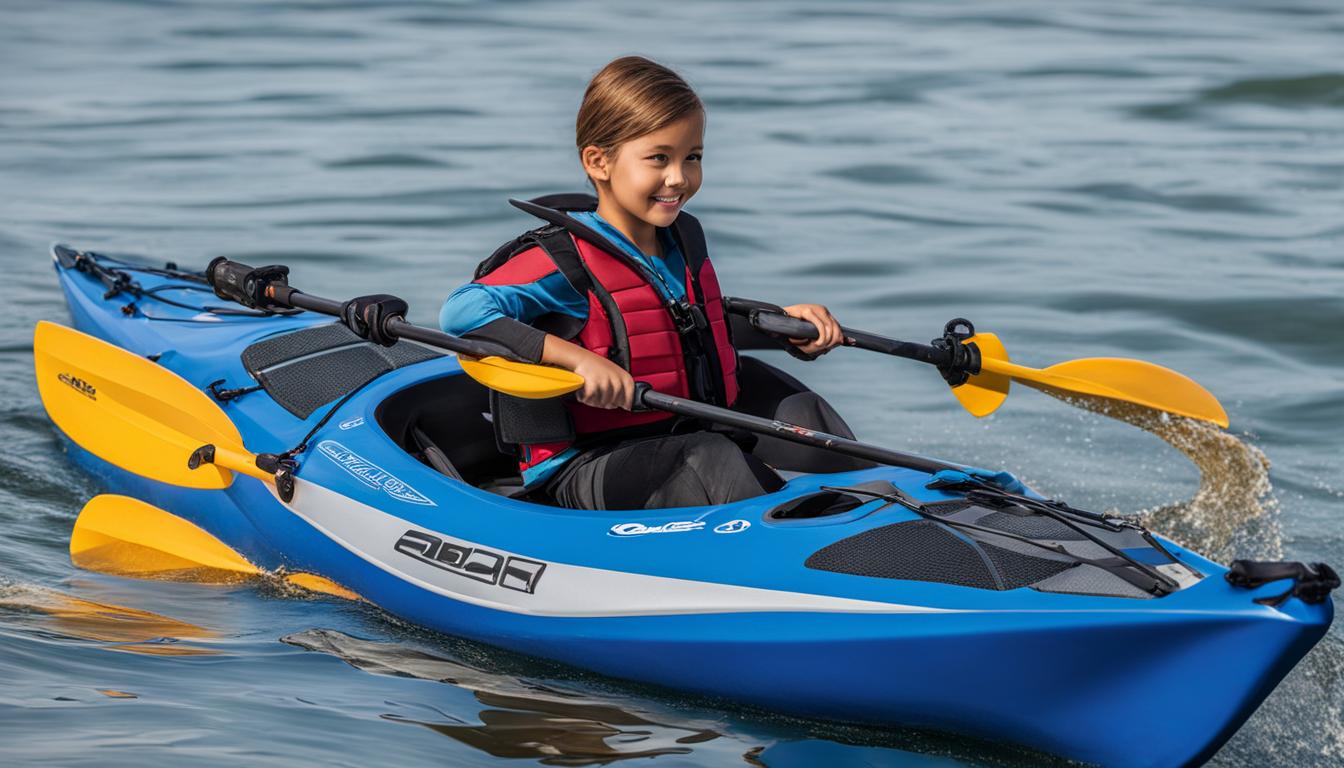When it comes to kayaking, comfort is key. A well-designed kayak cockpit can make all the difference in your paddling experience, especially on long trips. That’s why ergonomic cockpit designs are so important. By prioritizing comfort, functionality, and customization, you can create a cockpit setup that suits your needs and allows you to enjoy your time on the water to the fullest.
Key Takeaways:
- Ergonomic kayak cockpit designs play a crucial role in enhancing comfort and efficiency.
- Consider different cockpit designs and their advantages and disadvantages to find the one that suits you best.
- Customize your cockpit with adjustable features like seats, thigh braces, and foot pegs for optimal comfort and control.
- Innovations in cockpit layout and seat design can significantly improve your paddling experience.
- When planning for long trips, prioritize comfort and efficiency in your cockpit setup.
Ergonomic Considerations in Kayak Cockpits
When it comes to designing a kayak cockpit, there are several important ergonomic considerations to keep in mind. These considerations play a crucial role in ensuring comfort and efficiency for paddlers, especially during long trips. One key aspect to consider is the positioning of the knees within the cockpit. Different cockpit designs offer various knee placement options, which can affect both boat control and paddler comfort.
For example, cockpits that allow the knees to be placed under the middle of the deck, such as Greenland or ocean cockpits, provide better boat control in rough water conditions. However, entering and exiting these types of cockpits may require more effort. On the other hand, keyhole cockpits allow the knees to be positioned out to the side, offering good boat control and speed/safety during rough water landings. However, they may restrict forward paddling form and force the legs into an angled position, reducing the effectiveness of torso rotation. Open or exposed cockpits provide improved forward paddling and freedom of movement, but they may lack boat control in rough water. Keyhole compromise designs aim to provide a more centered knee position while retaining the advantages of the standard keyhole cockpit.
To summarize, choosing a kayak cockpit design that aligns with your paddling style and comfort preferences is essential. Consider the ergonomics of the cockpit, including knee placement options, to ensure an optimal paddling experience. By selecting a comfortable cockpit setup, you can enhance your efficiency and enjoyment on the water during long trips.
Ergonomic Considerations in Kayak Cockpits
| Cockpit Design | Advantages | Disadvantages |
|---|---|---|
| Greenland or ocean cockpits | Excellent boat control in rough waters | More effort during entry and exit |
| Keyhole cockpits | Good boat control and easy access to the kayak | Restrict forward paddling form, force angled leg position |
| Open or exposed cockpits | Freedom of movement for forward paddling | Lack boat control in rough water |
| Keyhole compromise designs | Balance between boat control and improved forward paddling | N/A |
Table: Ergonomic considerations in different kayak cockpit designs
Custom Cockpit Designs for Specific Needs
When it comes to kayaking, comfort and functionality are key. Every paddler has different needs and preferences, and a custom cockpit design can provide the perfect solution. Whether you’re looking to enhance boat control, improve connection with the kayak, or alleviate discomfort during long trips, custom cockpit designs can cater to your specific requirements.
One way to enhance cockpit functionality is through cockpit adjustments. Adding thigh braces or foam blocks can improve boat control and allow for a more customized fit. These adjustments provide better stability and control, especially in rough waters. Additionally, modifications such as additional back support or padding can alleviate discomfort and prevent fatigue during long trips.
“A custom cockpit can be a game-changer for paddlers. It allows you to fine-tune the fit and functionality of your kayak, ultimately improving your performance on the water,” says experienced kayak outfitter, Jane Smith.
Working with experienced kayak outfitters and manufacturers is crucial when designing a custom cockpit. These professionals can provide valuable insights and guidance to help you create a cockpit that maximizes your performance and enjoyment. By customizing your cockpit design, you’ll have a kayak that is tailored to your specific needs, allowing you to paddle with comfort, control, and confidence.
Custom Cockpit Design Example
To illustrate the possibilities of custom cockpit designs, we present an example of a modified cockpit layout for improved functionality:
| Custom Cockpit Feature | Description |
|---|---|
| Adjustable Seat | An ergonomic seat that can be adjusted for optimal comfort and support. |
| Thigh Braces | Customizable thigh braces that provide enhanced stability and control. |
| Integrated Foot Pegs | Foot pegs that are adjustable and offer a secure connection with the kayak for improved paddling efficiency. |
| Additional Padding | Extra padding in key areas to alleviate pressure points and enhance comfort during long trips. |
| Easy Access Hatch | A hatch system that allows for convenient storage of essential gear and supplies within reach. |
By incorporating these custom features, paddlers can create a cockpit that provides optimal control, comfort, and functionality for their specific needs. Remember, investing in a custom cockpit design is an investment in your kayaking experience, allowing you to fully enjoy every moment on the water.
Innovative Cockpit Layouts for Comfort
When it comes to kayak cockpit design, comfort is key. Innovations in cockpit layouts have been developed to provide kayakers with enhanced comfort during their paddling adventures. One such innovation is the introduction of ergonomic seats and seat pads. These features offer improved support and cushioning, allowing kayakers to maintain a comfortable posture and reduce fatigue during long trips.
In addition to ergonomic seats, advancements have also been made to improve access and exit from the kayak. Larger cockpit openings and lower decks have been implemented to make it easier for kayakers to enter and exit the boat, even in challenging conditions. This ensures that paddlers can spend less time struggling with their entry and exit and more time enjoying the water.
Another aspect of innovative cockpit layouts is the integration of adjustable features. Many modern kayaks offer adjustable footrests and thigh pads, allowing paddlers to customize the cockpit to their specific needs. These adjustments not only enhance comfort but also improve control and efficiency on the water. By providing a customizable cockpit layout, kayakers can create a personalized setup that suits their body and paddling style.
“The innovations in kayak cockpit layouts have greatly improved comfort and accessibility for paddlers. With ergonomic seats, larger openings, and adjustable features, kayakers can now enjoy a more comfortable and user-friendly experience on the water.”
| Features | Benefits |
|---|---|
| Ergonomic seats and seat pads | Improved support and cushioning |
| Larger cockpit openings | Easier entry and exit, especially in challenging conditions |
| Lower decks | Reduced struggle during entry and exit |
| Adjustable footrests and thigh pads | Customizable cockpit setup for enhanced comfort, control, and efficiency |
Overall, the innovative cockpit layouts in modern kayaks provide paddlers with a more comfortable and accessible experience. With features such as ergonomic seats, larger openings, and adjustable components, kayakers can choose a cockpit design that suits their needs and enhances their enjoyment on the water.
Enhancing Cockpit Functionality for Kayakers
Modern kayak cockpits are designed to enhance functionality and optimize the paddling experience for kayakers. With various ergonomic features and adjustable components, these cockpits offer enhanced control and comfort. By making cockpit adjustments and utilizing the ergonomic features, kayakers can achieve optimal functionality and efficiency on the water.
Adjustable Seats and Backrests
A key feature of modern kayak cockpits is the availability of adjustable seats and backrests. These allow kayakers to customize their seating position for maximum comfort and support. By adjusting the seat angle and backrest height, paddlers can alleviate pressure points and maintain proper posture during long trips. This not only enhances comfort but also reduces fatigue and improves paddling efficiency.
Thigh Braces and Knee Tubes
Another important feature in kayak cockpits is the inclusion of thigh braces and knee tubes. These components provide kayakers with better boat control and maneuverability. The thigh braces help secure the paddler’s legs in place, allowing for more precise movements and improved connection with the boat. Knee tubes offer additional support and stability, enhancing overall control and reducing the risk of injuries during rough water conditions.
“The adjustable seats and thigh braces in modern kayak cockpits have significantly improved my paddling experience. I can easily find a comfortable position and have better control over my boat. It has enhanced my efficiency and enjoyment on the water.”
– Experienced kayaker
Foot Pegs and Bulkheads
Foot pegs and bulkheads are essential components that contribute to cockpit functionality. Adjustable foot pegs allow paddlers to fine-tune their leg positioning, providing better leverage and control while paddling. They also help maintain proper posture and facilitate efficient power transfer. Bulkheads, on the other hand, serve as bracing points, improving stability and allowing for a more secure fit within the cockpit. These features work together to optimize control and enhance paddling performance.
In conclusion, modern kayak cockpits are equipped with ergonomic features that enhance functionality for kayakers. With adjustable seats, thigh braces, foot pegs, and bulkheads, paddlers can customize their cockpit setup for optimal control and comfort. These advancements in cockpit design contribute to a more enjoyable and efficient kayaking experience, allowing for longer trips and better overall performance on the water.
Designing a User-Friendly Kayak Cockpit
When it comes to designing a user-friendly kayak cockpit, easy access and exit are key considerations. Whether you’re a seasoned paddler or a beginner, a well-designed cockpit can make a significant difference in your kayaking experience. By prioritizing comfort, customization, and functionality, you can create a cockpit that suits your specific needs and maximizes your enjoyment on the water.
Easy Access and Exit
One of the most important aspects of a user-friendly cockpit is easy access and exit. This is especially important for paddlers with limited mobility or when navigating challenging water conditions. A spacious cockpit with a wide opening allows for effortless entry and exit, making it easier to get in and out of the kayak. Additionally, a lower deck height reduces the distance you need to lift your legs, making it more comfortable and convenient to enter and exit the boat.
Customization for Specific Needs
Every paddler has unique preferences and requirements. That’s why custom cockpit designs are becoming increasingly popular. With customizable features such as adjustable seats, thigh braces, and foot pegs, you can tailor your cockpit to suit your body type and paddling style. Customization options also extend to additional accessories such as back supports, padding, or storage solutions to enhance comfort and convenience during your kayaking adventures.
Optimal Control and Functionality
A user-friendly cockpit should offer optimal control and functionality. The placement of key elements such as foot pegs, thigh braces, and backrests should be adjustable to ensure a comfortable and efficient paddling position. This allows you to maintain proper posture, reduce fatigue, and improve overall performance on the water. By fine-tuning these elements, you can enhance your connection with the kayak and achieve better control and maneuverability.

Designing a user-friendly kayak cockpit involves a thoughtful balance between easy access and exit, customization options, and optimal control and functionality. By taking these factors into consideration, you can create a cockpit that offers a comfortable and enjoyable kayaking experience. Whether you’re planning a leisurely paddle or embarking on a long-distance trip, a well-designed cockpit will enhance your time on the water and make every moment unforgettable.
Comfortable Cockpit Setups for Long Trips
When embarking on long kayaking trips, it’s essential to have a comfortable cockpit setup that prioritizes ergonomics and promotes efficient paddling. By considering various factors such as seat padding, back support, knee position, and leg control, you can create a cockpit that enhances your comfort and enjoyment on the water.
One key aspect of a comfortable cockpit setup is the seating arrangement. Investing in a kayak with proper seat padding and support can prevent discomfort and fatigue during extended paddling sessions. Adjustable seat backrests allow you to find the ideal position for your back, ensuring proper alignment and reducing strain. Additionally, thigh braces can be added to provide support and stability, allowing for a more controlled and efficient paddling stroke.
Furthermore, the positioning of foot pegs or bulkheads is crucial for maintaining proper leg and foot support. Having adjustable foot pegs ensures that your feet are positioned in the most comfortable and ergonomic manner, allowing for efficient power transfer and reducing the risk of cramping or discomfort. Consider adding foam padding or customizing the foot pegs to match your specific needs and preferences.

Lastly, having convenient storage options within the cockpit is essential for long trips. Deck bags or hatch systems can provide easy access to essential gear and supplies, eliminating the need to constantly reach behind or disassemble your kayak to retrieve items. This not only saves time but also ensures that everything you need is within arm’s reach, allowing you to maintain a smooth and uninterrupted paddling experience.
By prioritizing comfort and functionality in your cockpit setup, you can enjoy long kayaking trips with ease and confidence. Experiment with different adjustments, customizations, and storage solutions to find the optimal combination that suits your needs. Remember, a comfortable cockpit not only enhances your physical well-being but also contributes to a more enjoyable and memorable kayaking experience.
Conclusion
Ergonomic kayak cockpits are essential for enhancing your comfort and efficiency as a kayaker. By considering factors such as cockpit shape, knee position, back support, and leg control, you can choose a cockpit design that best suits your needs. Custom cockpit options provide the opportunity to tailor your kayak to your specific preferences and requirements, ensuring optimal functionality on the water.
Innovative cockpit layouts are continuously being developed to provide enhanced comfort during your kayaking adventures. With ergonomic seats and seat pads, you can maintain a comfortable posture and reduce fatigue on long trips. Additionally, advancements in cockpit design have focused on improving access and exit, making it easier for you to enter and exit the boat even in challenging conditions.
When it comes to long trips, comfortable cockpit setups are crucial. Proper seat padding, adjustable backrests, and thigh braces allow you to find the most comfortable and efficient paddling position. Consider the positioning of foot pegs or bulkheads to provide proper leg and foot support. And don’t forget about storage options within the cockpit, such as deck bags or hatch systems, to keep your gear easily accessible throughout your journey.
Whether you’re embarking on a long-distance kayaking trip or enjoying a leisurely paddle, investing in a well-designed and ergonomic cockpit will significantly enhance your kayaking experience. So, take the time to explore the various cockpit options available, customize your kayak to your specific needs, and enjoy the comfort and functionality of your new cockpit design.
FAQ
What role does ergonomics play in kayak cockpit design?
Ergonomics plays a crucial role in kayak cockpit design as it directly affects comfort and efficiency for kayakers.
What are the different types of kayak cockpit designs?
There are various cockpit designs to choose from, including Greenland or ocean cockpits, standard keyhole cockpits, open or exposed cockpits, and keyhole compromise designs.
How does the positioning of the knees affect cockpit design?
The positioning of the knees can impact boat control and paddling form. Cockpits that allow the knees to be placed under the middle of the deck provide better boat control in rough water, while cockpits that allow the knees to be positioned out to the side offer good boat control and easy access to the kayak.
Can a kayak cockpit be customized?
Yes, kayak cockpits can be customized to suit individual preferences and requirements. Custom cockpit designs allow for enhancements such as adding thigh braces or foam blocks for improved boat control and a more tailored fit.
What are some innovative features in modern kayak cockpits?
Modern kayak cockpits are equipped with ergonomic seats and backrests, thigh braces and knee tubes for improved control, adjustable foot pegs and bulkheads for optimized connection with the kayak, and integrated features such as adjustable footrests and thigh pads.
What factors should be considered when designing a user-friendly kayak cockpit?
Factors such as accessibility, ease of entry and exit, cockpit size and shape, and customization options should be considered when designing a user-friendly kayak cockpit.
What should be considered for comfortable cockpit setups during long trips?
Comfortable cockpit setups for long trips should prioritize proper seat padding and support, adjustable seat backrests and thigh braces, and proper leg and foot support through positioning of foot pegs or bulkheads.





